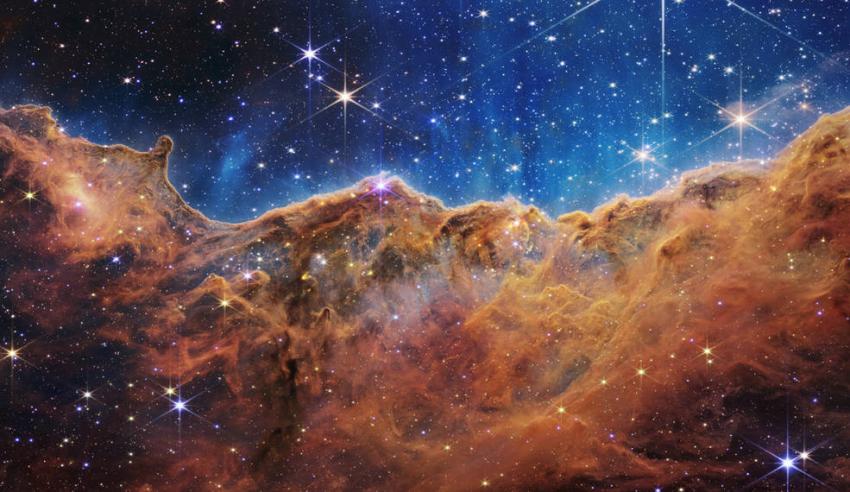Astronomers at the 2022 National Astronomy Meeting today celebrated the release of new images and data from the James Webb Space Telescope (JWST), following the release of the very first image from the telescope by President Biden on 11 July. Together, the five images form the complete set of the first full-colour images and spectral data from JWST.
The brand new images show the first targets of the telescope: The Carina Nebula, one of the largest and brightest nebulae in the sky; the Southern Ring Nebula, an expanding cloud of gas, surrounding a dying star; Stephan’s Quintet, a compact galaxy group; and the spectrum of WASP-96 b, a giant planet outside our solar system, composed mainly of gas.
RAS President, Professor Mike Edmunds, says, “To gaze so far out into the Universe and back in the past is such a privilege for us all. I am really looking forward to the new fundamental results which will come from the detailed analysis of these observations. Astronomers all around the world will be delighted to see how well this extraordinary telescope is performing. Well done everyone.”
Media contacts
Dr Robert Massey
Royal Astronomical Society
Tel: +44 (0)20 7292 3979
Mob: +44 (0)7802 877 699
nam-press@ras.ac.uk
Ms Gurjeet Kahlon
Royal Astronomical Society
Mob: +44 (0)7802 877700
nam-press@ras.ac.uk
Ms Cait Cullen
Royal Astronomical Society
nam-press@ras.ac.uk
Science contacts
Professor Mike Edmunds
Royal Astronomical Society
m.g.edmunds@gmail.com
Further information
The full set of images is available at https://www.nasa.gov/webbfirstimages
Notes for editors
About the James Webb Space Telescope
The James Webb Space Telescope is the world's premier space science observatory. Webb will solve mysteries in our solar system, look beyond to distant worlds around other stars, and probe the mysterious structures and origins of our universe and our place in it. Webb is an international program led by NASA, the ESA (European Space Agency) and CSA (Canadian Space Agency).
About NAM 2022
The NAM 2022 conference is principally sponsored by the Royal Astronomical Society (RAS), the Science and Technology Facilities Council (STFC) and the University of Warwick. Keep up with the latest conference news on Twitter.
About the Royal Astronomical Society
The Royal Astronomical Society (RAS), founded in 1820, encourages and promotes the study of astronomy, solar-system science, geophysics and closely related branches of science. The RAS organises scientific meetings, publishes international research and review journals, recognises outstanding achievements by the award of medals and prizes, maintains an extensive library, supports education through grants and outreach activities and represents UK astronomy nationally and internationally. Its more than 4,000 members (Fellows), a third based overseas, include scientific researchers in universities, observatories and laboratories as well as historians of astronomy and others.
Follow the RAS on Twitter, Facebook, Instagram and YouTube. Listen and subscribe to the Supermassive Podcast here.
About the Science and Technology Facilities Council
The Science and Technology Facilities Council (STFC) is part of UK Research and Innovation – the UK body which works in partnership with universities, research organisations, businesses, charities, and government to create the best possible environment for research and innovation to flourish. STFC funds and supports research in particle and nuclear physics, astronomy, gravitational research and astrophysics, and space science and also operates a network of five national laboratories, including the Rutherford Appleton Laboratory and the Daresbury Laboratory, as well as supporting UK research at a number of international research facilities including CERN, FERMILAB, the ESO telescopes in Chile and many more.
STFC's Astronomy and Space Science programme provides support for a wide range of facilities, research groups and individuals in order to investigate some of the highest priority questions in astrophysics, cosmology and solar system science. STFC's astronomy and space science programme is delivered through grant funding for research activities, and also through support of technical activities at STFC's UK Astronomy Technology Centre and RAL Space at the Rutherford Appleton Laboratory. STFC also supports UK astronomy through the international European Southern Observatory and the Square Kilometre Array Organisation.
Follow STFC on Twitter.
About the University of Warwick
The University of Warwick is one of the world’s leading research institutions, ranked in the UK’s top 10 and world top 80 universities. Since its foundation in 1965 Warwick has established a reputation of scientific excellence, through the Faculty of Science, Engineering and Medicine (which includes WMG and the Warwick Medical School).


